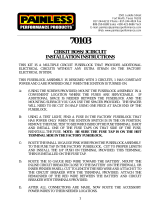
6
3.3 VOLTAGE CHECKS
1. Turn ON the UTILITY power supply to the trans-
fer switch using the UTILITY SERVICE DISCON-
NECT circuit breaker.
DANGER
PROCEED WITH CAUTION. THE TRANSFER SWITCH
IS NOW ELECTRICALLY HOT. CONTACT WITH LIVE
TERMINALS RESULTS IN EXTREMELY HAZARDOUS
AND POSSIBLY FATAL ELECTRICAL SHOCK.
2. With an accurate AC voltmeter, check for correct
voltage. Measure across ATS terminal lugs N1
and N2. Also check N1 to NEUTRAL and N2 to
NEUTRAL.
3. When certain that UTILITY supply voltage is correct
and compatible with transfer switch ratings, turn
OFF the UTILITY supply to the transfer switch.
4. On the generator panel, set the AUTO/OFF/
MANUAL switch to MANUAL position. The gen-
erator should crank and start.
5. Let the generator stabilize and warm up at no-
load for at least five minutes.
6. Turn the GENERATOR DISCONNECT CIRCUIT
BREAKER to the ON position.
7. Set the generator's main circuit breaker (CB1) to
its ON or CLOSED position.
DANGER
PROCEED WITH CAUTION. GENERATOR
OUTPUT VOLTAGE IS NOW BEING DELIVERED
TO TRANSFER SWITCH TERMINALS. CONTACT
WITH LIVE TERMINALS RESULTS IN EXTREMELY
DANGEROUS AND POSSIBLY FATAL ELECTRICAL
SHOCK.
8. With an accurate AC voltmeter and frequency
meter, check the no-load, voltage and frequency.
Measure across ATS terminal lugs E1 to E2. Also
check E1 to NEUTRAL and E2 to NEUTRAL.
a. Frequency ....................................... 60-62 Hertz
b. Terminals E1 to E2 ........................ 240-246 VAC
c. Terminals E1 to NEUTRAL ............. 120-123 VAC
d. Terminals E2 to NEUTRAL ............. 120-123 VAC
9. Set the generator’s main circuit breaker (CB1) to
its OFF or OPEN position.
10. Set the AUTO/OFF/MANUAL switch to the OFF
position to shut down the generator.
NOTE:
Do NOT proceed until generator AC output volt-
age and frequency are correct and within stated
limits. If the no-load voltage is correct but no-load
frequency is incorrect, the engine governed speed
may require adjustment. If no-load frequency is
correct but voltage is not, the voltage regulator
may require adjustment.
3.4 GENERATOR TESTS UNDER LOAD
1. Set the generator's main circuit breaker to its
OFF or OPEN position.
2. Set the UTILITY SERVICE DISCONNECT circuit
breaker to the OFF position.
3. Manually actuate the transfer switch main con-
tacts to their GENERATOR (STANDBY) position.
Refer to "Manual Operation".
4. To start the generator, set the AUTO/OFF/ MANUAL
switch to MANUAL. When engine starts, let it sta-
bilize for a few minutes.
5. Turn the GENERATOR DISCONNECT CIRCUIT
BREAKER to the ON position.
6. Turn the generator's main circuit breaker to its
ON or CLOSED position. The generator now pow-
ers all LOAD circuits. Check generator operation
under load as follows:
• Turn ON electrical loads to the full rated watt-
age/amperage capacity of the generator. DO
NOT OVERLOAD.
• With maximum rated load applied, check
voltage and frequency across transfer switch
terminals E1 and E2. Voltage should be
greater than 230VAC and frequency should be
greater than 59 Hertz.
• Let the generator run under rated load for at
least 30 minutes. With unit running, listen for
unusual noises, vibration, overheating, etc.,
that might indicate a problem.
7. When checkout under load is complete, set main
circuit breaker of the generator to its OFF or
OPEN position.
8. Let the generator run at no-load for several min-
utes. Then, shut down by setting the AUTO/OFF/
MANUAL switch to its OFF position.
9. Turn the GENERATOR DISCONNECT circuit
breaker to the ON position.
10. Move the switch's main contacts back to their
UTILITY position. For example, LOAD connected
to UTILITY power supply. Refer to "Manual
Operation". Handle and operating lever of trans-
fer switch should be in UP position.
11. Turn on the utility power supply to transfer switch,
using the UTILITY SERVICE DISCONNECT cir-
cuit breaker. The utility power source now pow-
ers the loads.
12. Set the generator's AUTO/OFF/MANUAL switch to
its AUTO position.
13. Set the GENERATOR DISCONNECT SWITCH to
the ON position. The system is now set for fully
automatic operation.
Section 3 — Operation
RTS “HS” Type Transfer Switch






















